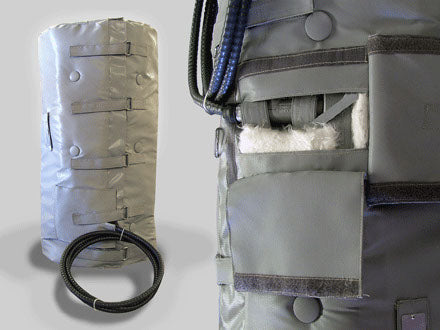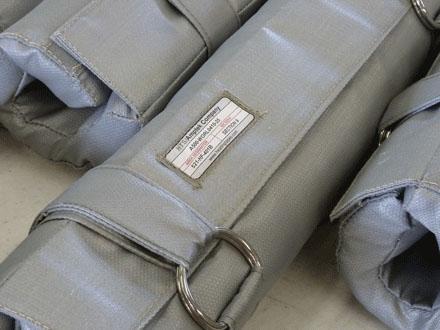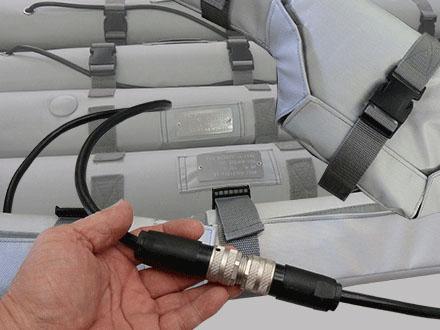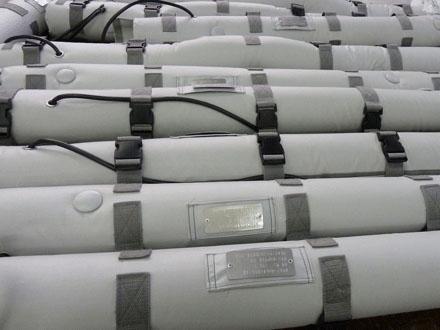
Heat Trace Jacket on Filter Set

Pipe Traced Jacket, D Ring Strap

Div 1 Heat Traced Jacket (Pwr Exit)

Pipe Traced Jacket With Connectors

Heat Traced Jacket Cable Shown

Heat Traced Jacket on 3 Gallon Can

Div 1 Heat Traced Flange

Heat Traced Cables with Seal Fittings

Pipe Heat Traced Jackets

Hazardous Area Fittings for Gas Bottle Jackets
ABOUT TRACE CABLE HEATING JACKETS
Custom Heat Traced Jackets for Freeze Protection and viscosity control offer quick and easy install and removal. Traced Heating Jackets are clean, modular, low watt density heaters. These custom designed, insulated Heating Jackets, use commercial Heat Tracing Cable for their heating elements. The robust, stitched construction configures into preformed shapes with Self Regulating Heating Cable inside, including the necessary hardware and termination fittings to maintain approvals for Hazardous and Non-Hazardous areas. Freeze protection is necessary to keep liquids flowing when weather conditions are not ideal. Viscosity Control, to flow thick liquids from oil to wax and chocolate, requires heating for proper temperature maintenance. Traced Jackets offer the advantage of being able to be removed and reinstalled, when valve or instrumentation maintenance is necessary.
Frequently Asked Questions
Temperature control mechanisms are recommended for all types of heating tapes. We provide temperature controls with heating tape systems to make one cohesive network, and we utilize existing controls. There are a variety of control mechanisms available and the best choice depends on the temperature, voltage, accuracy and output used in your system. A mechanical bulb and capillary thermostat are recommended for temperatures below 325 degrees F. For voltage control a variable transformer or solid-state Triac controller may be used. For precise temperature control you can activate from a bench-top or wall-mount, we recommend the BT-15 or WM-15. We supply a complete list of thermostats and similar mechanisms, and we are happy to help you select the ideal device for your needs.
Can I Leave the Unused Portion Rolled Up?
No, your heating tape will not function properly if it is not touching the heat sink from end to end. Rolled up heating tape can be hazardous, so be sure your heating tape is completely and properly installed.
How Can I Tell Which Side is "Up"?
Heating tape exhibits a uniform temperature on both sides. Either side of the heating tape may be applied to the heat sink.
Can I Cut Heat Tape?
No. Heating tapes utilize constant electric flow throughout and are designed for a fixed resistance at a given length and voltage. The tape is pre-designed to suit your environment and attempting to modify it will destroy the tape.
How Does Heat Tape Work?
Heating tapes utilize a constant watt density at a fixed resistance over a fixed length and voltage to create heat. Heat output is based on a given input voltage. Heat transference to pipes, floors and other surfaces occurs through direct contact with the tape. An insulator surrounding the enclosed heating element stops the heat from escaping and maintains a desired temperature. Temperature controls integrated into the circuit allow you to control the temperature.
Why Is Heat Tape Temperature Different in Some Places?
The materials inside the heating tape determine the operating temperature. Different heating tapes utilize different materials to create and maintain a desired temperature.
Can I Hook Heat Tape Up to a Thermostat?
Heating tapes effectively integrate with a wide variety of temperature control devices such as: thermostats, variable transformers, Triacs, solid-state digital temperature controls, programmable logic controllers (PLC's) or computers.
Why do I need different sized heat tape?
The size of your heating tape is determined by a variety of factors, including a proper mechanical fit, heat output, voltage and temperature rating, among others. Expert installers at HTS/Amptek® Company will help you select the correct heating tape size for your application to ensure optimal energy efficiency, safety and durability.
What heat tape sizes can I choose from?
HTS/Amptek® Company supplies a range of heating tape sizes to give you the best fit. Our heating tape sizes are available on our price list and online store. When choosing your heating tape, be sure to consider the heat output, voltage and temperature rating involved in your application. If you are not sure which size is best for you, contact us and we are happy to assist you.
Features AND Specifications

| Heating Element: | Commercial Heat Trace Cable |
| Watts, Volts: | 8w to 30w (ft) cable, 120V to 277/1 |
| Size: | Custom Modular Sizes for Convenient Install |
| Weight: | Modular, 50lbs (23kg) Max Recommended |
| Heat Capability: | -40°F (-40°C) to 250°F (121°C) |
| Max Exposure: | 375°F (190°C) |
| Power Leads: | Flex Conduit, SO Cord, Armored, Tech 90 |
| Power Plugs: | NEMA, Straight, Twist Loc, Pin & Sleeve |
| Sensors: | Process & Limit Thermocouple or RTD |
| Area Class: | Non-Haz, CL1 Div2, CL DIV1 |
| Controllers: | Single Console Control Panel Back |
TYPICAL AND SPECIAL FEATURES
Jacket sizes:
Large Heating Jackets are limited by weight, typically 50lbs (23kg), but may be constructed in multiples to fit large surfaces. Small Heating Jackets may be constructed to fit ¾ inch diameter tubing and fittings. Note that Heating cables are less flexible than HTS/Amptek® Heating Tape elements, and are difficult to fit in small Jacket formats.
Construction:
The Jacket inner fabric liner of Teflon or Silicone supports the mechanically attached Heat Trace Cable and Sensors. Insulation layers are placed over top and outer fabrics enclose the assembly. All Jackets are pre-formed and double stitched to form the necessary 3D shape. The materials of construction fabric choices include Teflon, Silicone, Neoprene, and Vinyl. Insulation types include Fiberglass Mat and closed-cell Foam varieties to provide durability, lighter weight and moisture protection.
The Self-Regulating Heating Element:
Self-Regulating heaters provide more heat at low temperatures and less heat as the ambient temperature warms. HTS/Amptek® selects the best available Trace Cable for the application. Whether the goal is freeze protection, viscosity control or process heating, there is a style of heater that would be best suited for the application.
Temperature Capability:
Heat Trace Cables are all rated for continuous and maximum exposure temperatures. This value varies depending upon the style of cable used. Generally, however, using the highest temperature rated cable available, we do not recommend use above 375°F (190°C).
Heated Zones:
Traced Jacket Systems, for freeze protection, may be designed to “daisy-chain” such that multiple Jackets can operate in a single zone. Jackets may have connecting plug and receptacle configurations so that they may be easy to remove and reinstall. For process applications, each Jacket may have its own dedicated power and sensor leads. Trace Calbe in-rush current is considered during circuit sizing.
Temperature sensors:
Built in thermal sensors such as RTDs or Thermocouples can be installed for process temperature measurement, or directly on the heating element for sensing limit temperature. Snap Switches and Thermostats may be used for limit, or low-cost temperature control solutions.
Cutouts and Penetrations:
Cut outs and slits for supports, ports and other hardware are typical of most applications. HTS/Amptek® designs preformed Jacket configurations with gusseted holes, slits and seams to provide great fit and easy install and removal. Additional flaps and straps cover the exposed seams.
Closures:
Most common Closures are Velcro® flap and D ring strap or lacing eye closure methods, however quicker and cleaner methods include convenient snaps or Delrin® Clips.
Contact: HTS/Amptek®
Call or email your questions, or click the quote button for a convenient form to help us with the size and scope of your application.










